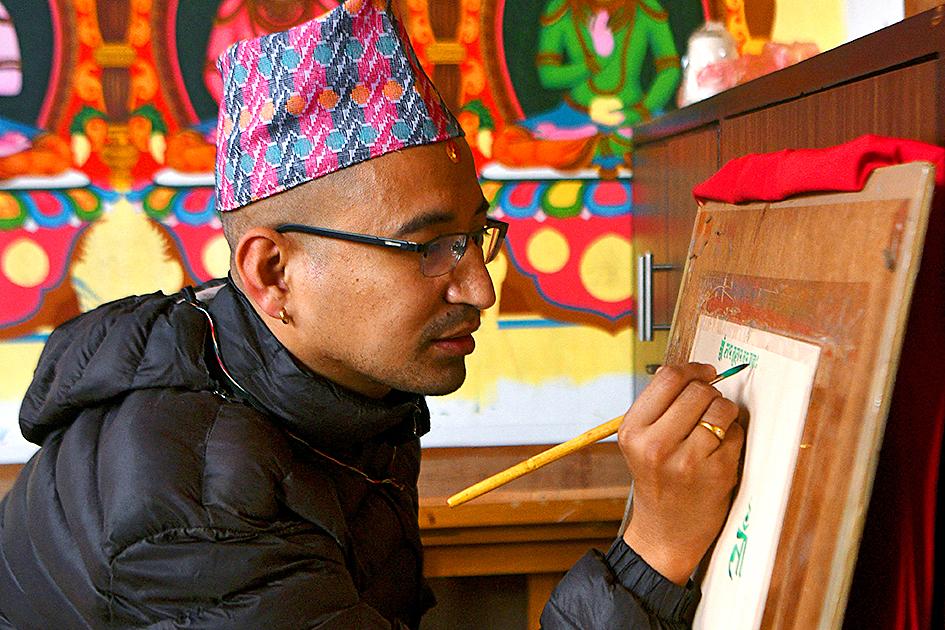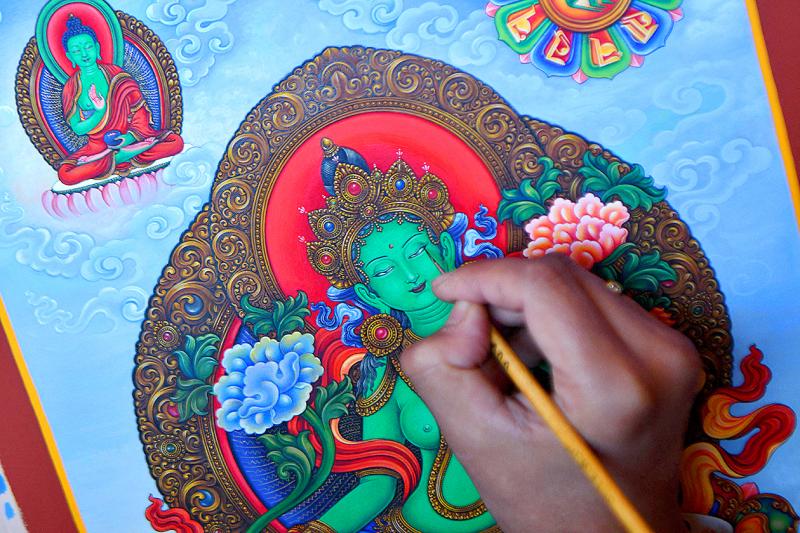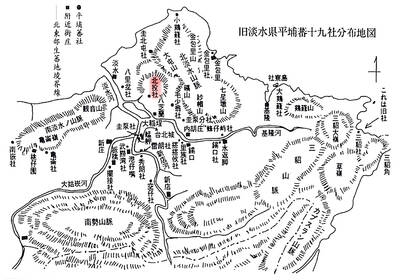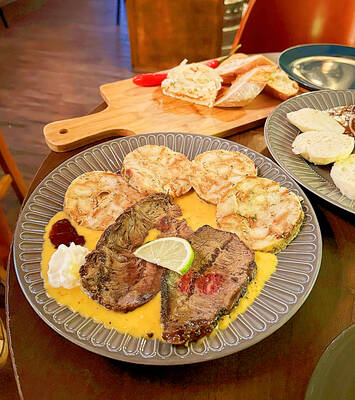With a shaved head and an empty stomach, artist Ujay Bajracharya dips his brush to line the eyes of the deity Tara as a soothing Buddhist hymn warbles in the background.
The 40-year-old is applying the final strokes to his paubha painting, a devotional art form known for its minute detail, intense colors and the strict purification rituals traditionally required of its practitioners. It took three months for Bajracharya to complete his rendition of the Green Tara, a goddess of compassion revered by Buddhists and Hindus in Nepal.
Before work began, he shaved off his hair and clipped his nails, while a Buddhist priest blessed his canvas and selected a day auspicious enough for the artist to commence his labors.

Photo: AFP
Bajracharya woke up early each morning and did not eat until his day’s work was over, adopting a strict vegetarian diet that also excluded garlic, tomatoes and onion when he broke his fast.
“My body felt light and I felt more focused and motivated to paint,” he said. “Changing my lifestyle was a bit difficult at first but I had the support of my family and friends, so that helped me stay disciplined.”
Paubha remains a common painting method in Nepal but the austere religious observances once followed by its artists have fallen out of practice.

Photo: AFP
Bajracharya’s adoption of these rituals began last year, when he approached a museum in the capital Kathmandu about painting another Buddhist deity while adhering to the forgotten traditions.
Rajan Shakya, founder of the Museum of Nepali Art, said that they immediately agreed to the idea of reviving the practice.
“It is part of what makes paubha art unique and valuable. The more people learn about it, the more demand there will be for Nepali artists. And then we know our art will survive, our culture will survive,” Shakya said.

Photo: AFP
Bajracharya has committed to observing these rules for future paintings, beginning with his exacting work on the Green Tara, which he crafted for worship in a private prayer room at his home.
“I felt that we should preserve this method and the next generation should also be aware — people should know about the spiritual aspect of these paintings,” he said.
Paubha artworks use cotton or silk canvases, and colors were traditionally made by grinding minerals and plants into fine powder. Some works even used pure gold and silver.
The oldest preserved paubha painting dates to the 13th century, but scholars believe the tradition is much older, with earlier examples likely disappearing because of the fragile materials used.
Its artists are believed to have inspired trends in thangkas, a similar type of devotional painting in neighboring Tibet that has been recognized in UNESCO’s list of intangible cultural heritage.
‘A FORM OF MEDITATION’
Priest Dipak Bajracharya — a member of Ujay’s caste but of no relation to the painter — said that in earlier times paubha artists would stay “pure” to ensure the sanctity of the images they produced.
“The process itself is considered a form of meditation,” he said.
While the traditional religious value remains, paubha paintings are now commonly seen as decorative hangings in museums or the homes of collectors.
A growing international appreciation for the craft has proven lucrative for artists, with interested buyers in China, Japan and Western countries.
“Paubha paintings have now become a business, but their aim is not commercial — they are actually objects of respect and worship,” the priest said.
Dipak returned to Ujay’s home once the latter’s hair had grown back for a final religious ceremony, culminating in a ritual to “breathe life” into the finished painting.
The ceremonial practice invites the Green Tara to reside in the work as a vessel for worship.
“This is not art alone, the faith of Buddhists and Hindus is tied to it,” said Ujay Bajracharya. “If we don’t preserve this art form, the faith will also slowly fade away.”

Seven hundred job applications. One interview. Marco Mascaro arrived in Taiwan last year with a PhD in engineering physics and years of experience at a European research center. He thought his Gold Card would guarantee him a foothold in Taiwan’s job market. “It’s marketed as if Taiwan really needs you,” the 33-year-old Italian says. “The reality is that companies here don’t really need us.” The Employment Gold Card was designed to fix Taiwan’s labor shortage by offering foreign professionals a combined resident visa and open work permit valid for three years. But for many, like Mascaro, the welcome mat ends at the door. A

The Western media once again enthusiastically forwarded Beijing’s talking points on Japanese Prime Minister Sanae Takaichi’s comment two weeks ago that an attack by the People’s Republic of China (PRC) on Taiwan was an existential threat to Japan and would trigger Japanese military intervention in defense of Taiwan. The predictable reach for clickbait meant that a string of teachable moments was lost, “like tears in the rain.” Again. The Economist led the way, assigning the blame to the victim. “Takaichi Sanae was bound to rile China sooner rather than later,” the magazine asserted. It then explained: “Japan’s new prime minister is

NOV. 24 to NOV. 30 It wasn’t famine, disaster or war that drove the people of Soansai to flee their homeland, but a blanket-stealing demon. At least that’s how Poan Yu-pie (潘有秘), a resident of the Indigenous settlement of Kipatauw in what is today Taipei’s Beitou District (北投), told it to Japanese anthropologist Kanori Ino in 1897. Unable to sleep out of fear, the villagers built a raft large enough to fit everyone and set sail. They drifted for days before arriving at what is now Shenao Port (深奧) on Taiwan’s north coast,

Divadlo feels like your warm neighborhood slice of home — even if you’ve only ever spent a few days in Prague, like myself. A projector is screening retro animations by Czech director Karel Zeman, the shelves are lined with books and vinyl, and the owner will sit with you to share stories over a glass of pear brandy. The food is also fantastic, not just a new cultural experience but filled with nostalgia, recipes from home and laden with soul-warming carbs, perfect as the weather turns chilly. A Prague native, Kaio Picha has been in Taipei for 13 years and